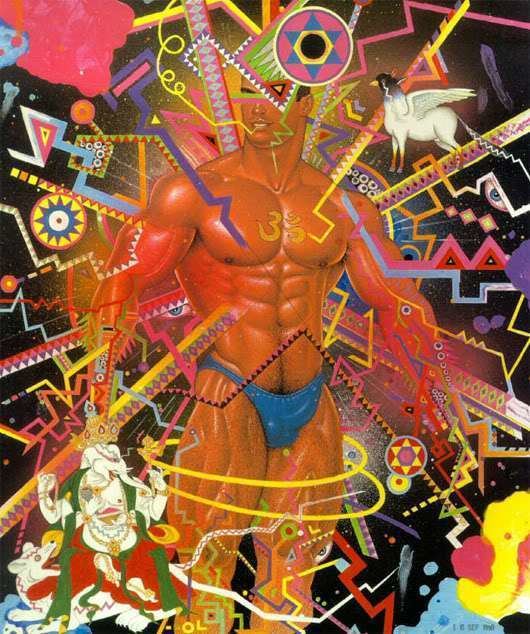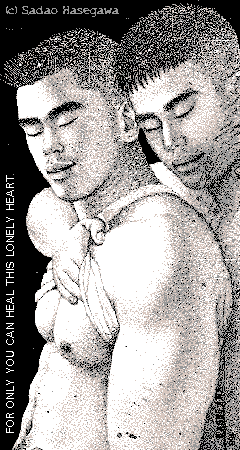Name Sadao Hasegawa | Role Artist | |
 | ||
Artwork Joyfully Seeking the Impure Land II, 1981, Dragon God | ||
Sadao Hasegawa (長谷川 サダオ, Hasegawa Sadao, 1950s – November 20, 1999) was a Japanese graphic artist specializing in male erotica. His work is notable for superb technical skills, elaborate fantastic settings (occasionally reminiscent of William Blake), and for incorporating Japanese, Indian, South-East Asian and African mythology. While focusing on depictions of muscular male physique, Hasegawa often turns to extreme sexual situations, bondage and SM themes, which, in the context of his stylized fantasy world, attain a nearly sacral intensity.
Contents

Aside from a few, intermittent appearances in gay magazines, Hasegawa Sadao's monograph Paradise Vision (1996 Kochi Studio) has been the only introduction of this talented artist in Japan. Gaining much attention overseas, with publications in the UK and numerous contributions to magazines in the US and Europe, Hasegawa's works have not been done justice in his home country. With great influences from Edo-Period shunga (erotic art), his obsession and display of beauty in the male body and sex combined with Asian motifs result in a truly concentrated representation of eroticism.

Hasegawa was born in the Tōkai area of Japan in the 1950s. Travels to India during his 20's and starts to take up drawing on his own. In 1973 he debuted his works on his first exhibition "Sadao Hasegawa's Alchemism-Meditation for 1973" in Tokyo, Japan, presents oil painting, collages, drawings and sculptures. In 1990 he published "Sadao Hasegawa" from G.M.P Co. England. Despite his overseas popularity, he however, has refused numerous offers to exhibit overseas, not wanting to distribute his works abroad. In 1990s he started to wandering around Indonesia (esp. Bali) and Thailand, the Balinese and Siamese imagery reflected on his works from this period, and some of Indonesian and Thai words are written on his works. One of his most celebrated work, the "Paradise Vision" was published by Kochi Studio in 1996. He ended his life by committing suicide on November 20, 1999 in Bangkok, Thailand. In 2000 Naruyama Gallery exhibited his last works "Linga", due to the request of the Sadao's family, who found a will requesting his posthumous exhibition written by Sadao before his death.

Suicide details

A few days before his death, Hasegawa had lunch with friend and American artist, John C. Goss. Jovial and witty as usual, he showed Goss photos of his latest paintings - a series depicting nude, Hindu-inspired male deities. These works would come to be exhibited at a memorial exhibition, along with a final series of starkly disembodied and erect phalluses unlike anything else Hasegawa ever created. Hasegawa's brother had cleaned out the artist's apartment and thrown out all of his works, unaware of their value, but rescued them after receiving a letter posted from Bangkok by Hasegawa asking that his works be sold at the Naruyama Gallery following his death. According to Toshie Urabe, who spoke with Hasegawa's brother, the only clues left at the scene of his death were a small piece of rope (he had asphyxiated himself using rope tied around a door knob) and a small stone on which he had painted a portrait of Yukio Mishima (Hasegawa's death preceded the anniversary of Mishima's own suicide).
